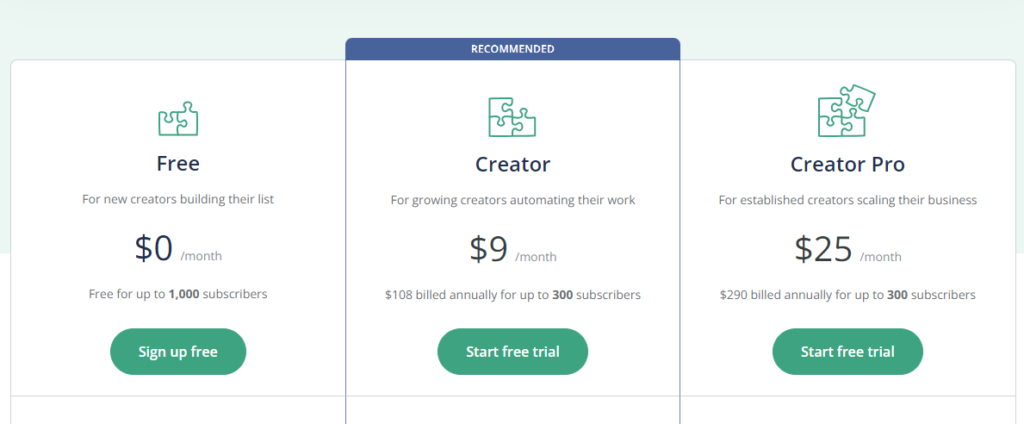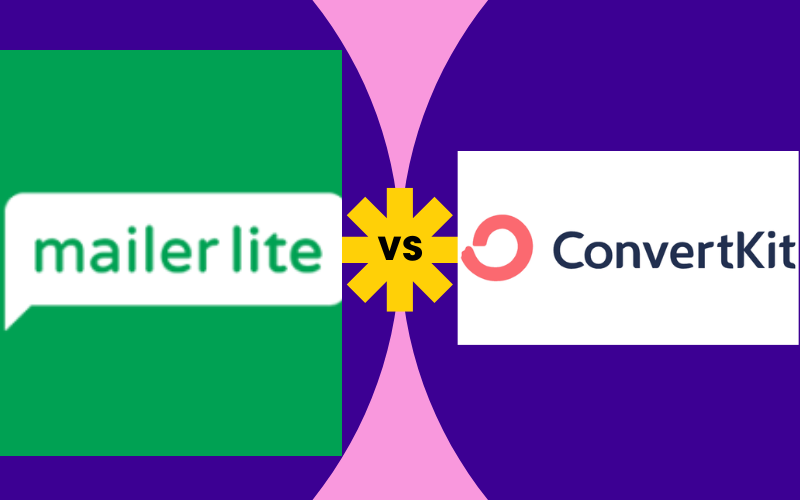Are you in search of the perfect email marketing platform to elevate your digital outreach?
Look no further! In today’s digital landscape, choosing the right email marketing platform is crucial for businesses and creators alike. In this comprehensive comparison, we’ll delve into the features, pricing, user interface, automation capabilities, integrations, customer support, deliverability, analytics, and customer reviews of two prominent platforms: MailerLite vs. ConvertKit. Whether you’re a seasoned marketer or just starting out, this guide will help you navigate the key differences between MailerLite and ConvertKit, allowing you to make an informed decision that aligns with your email marketing goals. Let’s dive in and explore the strengths and weaknesses of each platform to determine which one suits your needs best.
Pricing of MailerLite vs. ConvertKit:
When comparing MailerLite vs. ConvertKit, one of the first considerations for many users is the pricing structure. Both platforms offer various plans tailored to different needs and budgets.
MailerLite Pricing:
MailerLite offers a straightforward pricing model with a free plan for up to 1,000 subscribers. This plan includes essential features such as email campaigns, landing pages, and automation. As your subscriber list grows, pricing scales gradually, starting at $10 per month for up to 1,000 subscribers on the paid plan. Additional features such as custom HTML editor, A/B split testing, and advanced segmentation are unlocked as you move to higher tiers.

ConvertKit Pricing:
ConvertKit follows a similar pricing model, offering a free plan for up to 1,000 subscribers with basic features like email broadcasts and signup forms. Their paid plans start at $29 per month for up to 1,000 subscribers, which includes advanced features like automation, integrations, and customizable CTAs. As with MailerLite, pricing increases as your subscriber count grows, with additional features available at higher tiers.

Pricing Comparison:
Both MailerLite and ConvertKit offer competitive pricing structures, but the choice between the two ultimately depends on your specific needs and budget. MailerLite’s pricing may appeal to smaller businesses or those just starting with email marketing, while ConvertKit’s plans may be more suitable for users requiring advanced automation and customization features.
Features of MailerLite vs. ConvertKit:
When comparing MailerLite vs. ConvertKit, understanding the features offered by each platform is crucial in making an informed decision for your email marketing needs.
MailerLite Features:
MailerLite offers a comprehensive set of features designed to simplify email marketing for businesses of all sizes. Some key features include:
- Drag-and-Drop Editor: Easily create visually appealing email campaigns and landing pages with MailerLite’s intuitive drag-and-drop editor.
- Automation: Automate your email marketing campaigns with workflows and autoresponders based on subscriber actions and triggers.
- Segmentation: Target specific segments of your audience based on behavior, interests, or demographics for more personalized campaigns.
- A/B Testing: Test different email subject lines, content, and designs to optimize campaign performance and engagement.
- Analytics: Track and analyze the performance of your email campaigns with detailed analytics and reporting tools.

ConvertKit Features:
ConvertKit is known for its powerful automation and segmentation features tailored for creators and online businesses. Some key features include:
- Visual Automation Builder: Design complex automation workflows visually to engage subscribers at every stage of their journey.
- Tagging and Segmentation: Organize your subscribers into segments and apply tags based on their behavior and interests for targeted communication.
- Customizable Signup Forms: Create customized signup forms and landing pages to capture leads and grow your subscriber list.
- Advanced Reporting: Gain insights into subscriber engagement and campaign performance with detailed reporting and analytics.
- Integrations: Seamlessly integrate with third-party tools and platforms to streamline your email marketing workflow.

Features Comparison:
Both MailerLite and ConvertKit offer powerful features to help businesses succeed with their email marketing efforts. MailerLite’s user-friendly interface and straightforward features may appeal to beginners and small businesses, while ConvertKit’s advanced automation and segmentation capabilities are favored by creators and online businesses with more complex needs.
User Interface of MailerLite vs. ConvertKit:
The user interface plays a crucial role in the overall user experience of an email marketing platform. Let’s compare the user interfaces of MailerLite vs. ConvertKit to see how they stack up.
MailerLite User Interface:
MailerLite boasts a user-friendly and intuitive interface designed to streamline the email marketing process. The dashboard provides easy access to all essential features, including campaign creation, automation workflows, subscriber management, and analytics. Navigation is straightforward, with clear menu options and a clean layout that makes it easy for users to find what they need. The drag-and-drop editor for creating email campaigns and landing pages is intuitive, allowing users to design visually appealing content without any coding skills.

ConvertKit User Interface:
ConvertKit offers a minimalist and streamlined user interface focused on simplicity and functionality. The dashboard is clean and uncluttered, with easy access to key features such as automation workflows, subscriber management, forms, and reporting. The visual automation builder is a standout feature, allowing users to create complex automation sequences with ease. The interface prioritizes functionality over flashy design elements, providing a straightforward user experience for creators and online businesses.

User Interface Comparison:
Both MailerLite and ConvertKit provide user-friendly interfaces that prioritize ease of use and functionality. MailerLite’s interface may appeal to users looking for a more visually appealing and intuitive design, while ConvertKit’s minimalist approach is favored by those who prioritize simplicity and functionality.
Email Templates of MailerLite vs. ConvertKit:
Email templates play a significant role in creating visually appealing and professional-looking email campaigns. Let’s compare the available email templates in MailerLite vs. ConvertKit
MailerLite Email Templates:
MailerLite offers a wide range of professionally designed email templates to suit various occasions and purposes. Whether you’re sending a promotional email, newsletter, announcement, or event invitation, MailerLite has templates to fit your needs. These templates are fully customizable, allowing you to add your branding elements, images, and content to create personalized emails that resonate with your audience. With a drag-and-drop editor, customizing these templates is easy, even for users with no design experience.
ConvertKit Email Templates:
ConvertKit takes a minimalist approach to email templates, offering simple yet elegant designs that prioritize readability and engagement. While ConvertKit doesn’t have as many template options as MailerLite, the available templates are designed to be versatile and adaptable to various email marketing strategies. They focus on delivering a clean and clutter-free design, making it easy for subscribers to focus on the content of the email. ConvertKit also allows for customization, enabling users to add their branding elements and personalize the templates to match their brand aesthetic.
Email Templates Comparison:
Both MailerLite and ConvertKit offer email templates that cater to different needs and preferences. MailerLite provides a wider selection of templates with more customization options, making it suitable for users who value design flexibility and creativity. On the other hand, ConvertKit offers simpler and more streamlined templates that prioritize readability and engagement, appealing to users who prefer a minimalist design approach.
Automation of MailerLite vs. ConvertKit:
Automation is a pivotal aspect of any email marketing platform, allowing users to streamline their campaigns and engage with subscribers at the right time. Let’s delve into the automation features offered by MailerLite and ConvertKit.
MailerLite Automation:
MailerLite provides robust automation capabilities to help users create targeted and personalized email campaigns effortlessly. The platform offers an intuitive drag-and-drop editor for building automation workflows. Users can set up triggers and actions based on subscriber behavior, such as opening an email or clicking a link. MailerLite’s automation features include:
- Autoresponders: Send automated follow-up emails to subscribers based on their actions.
- Workflow Automation: Create complex automation sequences with ease using the visual editor.
- Behavior-Based Triggers: Trigger emails based on subscriber interactions with previous campaigns.
ConvertKit Automation:
ConvertKit is renowned for its powerful and visual automation builder, making it easy for users to create intricate automation sequences. The platform excels in providing automation tools tailored for creators and online businesses. ConvertKit’s automation features include:
- Visual Automation Builder: Design complex automation workflows visually.
- Tagging and Segmentation: Automatically apply tags and segment subscribers based on their behavior.
- Event-Based Triggers: Trigger actions based on specific events, such as a subscriber making a purchase.
Automation Comparison:
Both MailerLite and ConvertKit offer robust automation features, but their approaches cater to different user preferences. MailerLite’s automation is user-friendly and suitable for a wide range of users, while ConvertKit’s visual automation builder is especially powerful for creators with intricate automation needs.
Integrations of MailerLite vs. ConvertKit:
Integrations play a vital role in expanding the functionality of email marketing platforms by connecting them with other tools and services. Let’s compare the integrations offered by MailerLite and ConvertKit.
MailerLite Integrations:
MailerLite offers a range of integrations with popular third-party tools and services to streamline your email marketing workflow. Some key integrations include:
- E-commerce Platforms: Integrate with platforms like Shopify, WooCommerce, and BigCommerce to sync customer data and automate email campaigns.
- CRM Software: Connect with CRM systems like HubSpot, Salesforce, and Zoho CRM to keep your customer data in sync and streamline your sales and marketing efforts.
- Lead Generation Tools: Integrate with lead generation tools like OptinMonster and Sumo to capture leads and grow your subscriber list.
- Analytics and Tracking: Connect with analytics platforms like Google Analytics and Facebook Pixel to track the performance of your email campaigns and website traffic.
ConvertKit Integrations:
ConvertKit offers a wide range of integrations with tools and services that cater to creators and online businesses. Some key integrations include:
- E-commerce Platforms: Integrate with platforms like Shopify and Gumroad to sync customer data and segment subscribers based on their purchase behavior.
- Content Management Systems: Connect with CMS platforms like WordPress to seamlessly embed forms and landing pages on your website and capture leads.
- Marketing and Automation Tools: Integrate with tools like Zapier and Pabbly Connect to automate workflows and connect ConvertKit with other platforms and services.
- Payment Gateways: Integrate with payment gateways like PayPal and Stripe to automate email notifications for purchases and subscriptions.
Integrations Comparison:
Both MailerLite and ConvertKit offer a wide range of integrations to enhance your email marketing efforts and streamline your workflow. The choice between the two platforms may depend on the specific tools and services you use in your business and how well they integrate with each platform.
Customer Support of MailerLite vs. ConvertKit:
Customer support is crucial when it comes to choosing an email marketing platform, as reliable support ensures you can get assistance when needed. Let’s compare the customer support options offered by MailerLite and ConvertKit.
MailerLite Customer Support:
MailerLite prides itself on providing responsive and helpful customer support to its users. The platform offers various support channels to assist users with their questions and issues:
- Email Support: Users can reach out to MailerLite’s support team via email for assistance with technical issues, account inquiries, and general questions.
- Knowledge Base: MailerLite’s extensive knowledge base includes helpful articles, tutorials, and guides covering various aspects of using the platform, from getting started to advanced features.
- Live Chat: MailerLite offers live chat support during business hours, allowing users to get real-time assistance from support agents.
ConvertKit Customer Support:
ConvertKit is known for its excellent customer support tailored to creators and online businesses. The platform offers several support options to help users resolve their queries and concerns:
- Email Support: Users can contact ConvertKit’s support team via email for assistance with technical issues, account-related questions, and other inquiries.
- Knowledge Base: ConvertKit’s knowledge base includes a comprehensive collection of articles, tutorials, and resources to help users learn how to use the platform effectively.
- Creator Community: ConvertKit hosts a thriving community of creators where users can ask questions, share tips and strategies, and connect with other users.
Customer Support Comparison:
Both MailerLite and ConvertKit offer responsive customer support and comprehensive knowledge bases to assist users with their email marketing needs. The choice between the two platforms may come down to personal preferences regarding support channels and the availability of community resources.
Deliverability of MailerLite vs. ConvertKit:
Email deliverability is a critical factor in the success of your email marketing campaigns, as it determines whether your emails reach your subscribers’ inboxes or end up in spam folders. Let’s compare the deliverability rates of MailerLite vs. ConvertKit
MailerLite Deliverability:
MailerLite prioritizes email deliverability to ensure that your messages reach your subscribers’ inboxes consistently. The platform employs various strategies and best practices to maximize deliverability rates, including:
- Dedicated IP Addresses: MailerLite offers dedicated IP addresses for users on higher-tier plans, which can improve deliverability by establishing a reputation for your sending domain.
- Authentication Protocols: MailerLite supports authentication protocols like SPF, DKIM, and DMARC to verify the authenticity of your emails and prevent them from being marked as spam.
- List Hygiene: MailerLite regularly monitors and maintains its infrastructure to ensure optimal deliverability, including managing bounce rates and handling spam complaints.
ConvertKit Deliverability:
ConvertKit also prioritizes email deliverability to ensure that your messages reach your subscribers’ inboxes reliably. The platform employs several measures to maintain high deliverability rates, including:
- Shared IP Pool: ConvertKit uses a shared IP pool to send emails, which can help maintain a positive reputation for all users and improve deliverability.
- Authentication Protocols: ConvertKit supports authentication protocols like SPF and DKIM to verify the authenticity of your emails and enhance deliverability.
- List Segmentation: ConvertKit encourages users to segment their subscriber lists based on engagement levels and interests, which can improve deliverability by sending targeted and relevant content to subscribers.
Deliverability Comparison:
Both MailerLite and ConvertKit prioritize email deliverability and employ various strategies to ensure that your emails reach your subscribers’ inboxes reliably. While MailerLite offers dedicated IP addresses for higher-tier plans, ConvertKit’s shared IP pool can also maintain high deliverability rates for all users.
Analytics and Reporting of MailerLite vs. ConvertKit:
Analyzing the performance of your email marketing campaigns is essential for optimizing your strategies and improving engagement with your subscribers. Let’s compare the analytics and reporting features offered by MailerLite and ConvertKit.
MailerLite Analytics and Reporting:
MailerLite provides comprehensive analytics and reporting tools to help users track the performance of their email campaigns effectively. Some key features include:
- Campaign Performance: MailerLite offers detailed insights into the performance of your email campaigns, including open rates, click-through rates, and subscriber engagement metrics.
- A/B Testing: Users can conduct A/B tests to compare different email variations and determine which performs better in terms of engagement and conversion rates.
- Segmentation Metrics: MailerLite allows users to track the performance of segmented subscriber lists, providing insights into the effectiveness of targeted campaigns.
- Automation Analytics: Users can monitor the performance of their automation workflows, including workflow completion rates and subscriber actions.
ConvertKit Analytics and Reporting:
ConvertKit offers robust analytics and reporting features tailored to creators and online businesses. Some key features include:
- Subscriber Engagement: ConvertKit provides insights into subscriber engagement metrics, including open rates, click-through rates, and subscriber growth over time.
- Tag Performance: Users can track the performance of tags applied to subscribers, helping them understand subscriber interests and behaviors.
- Automation Analytics: ConvertKit offers analytics for automation workflows, allowing users to monitor the performance of their automated sequences and identify areas for optimization.
- Revenue Tracking: ConvertKit integrates with e-commerce platforms to track revenue generated from email campaigns, providing valuable insights into the ROI of email marketing efforts.
Analytics and Reporting Comparison:
Both MailerLite and ConvertKit offer comprehensive analytics and reporting tools to help users track and optimize their email marketing campaigns. While MailerLite provides detailed insights into campaign performance and A/B testing, ConvertKit excels in subscriber engagement metrics and revenue tracking for creators and online businesses.
Customer Reviews of MailerLite vs. ConvertKit:
Customer reviews provide valuable insights into the experiences of users who have used MailerLite and ConvertKit for their email marketing needs. Let’s explore some customer reviews to understand how each platform is perceived by its users.
MailerLite Customer Reviews:
“Easy to Use and Great Features!”
- “I’ve been using MailerLite for my email marketing campaigns, and I love how easy it is to use. The drag-and-drop editor makes creating beautiful emails a breeze, and the automation features have saved me so much time. Highly recommend!”
- “MailerLite’s customer support is top-notch. Whenever I’ve had a question or issue, their team has been quick to respond and very helpful. Plus, the pricing is unbeatable for the features you get.”
“Excellent Deliverability and Analytics!”
- “I switched to MailerLite from another email marketing platform, and I’ve been impressed with the deliverability rates. My emails consistently land in my subscribers’ inboxes, and the detailed analytics help me track the performance of my campaigns.”
- “I love how MailerLite provides actionable insights into my subscriber engagement. The analytics dashboard is easy to understand, and the A/B testing feature has helped me optimize my emails for better results.”
ConvertKit Customer Reviews:
“Perfect for Creators and Bloggers!”
- “ConvertKit is my go-to email marketing platform for my blog, and it’s been fantastic. The visual automation builder is a game-changer, allowing me to create complex automation sequences without any coding skills. Plus, the segmentation features help me send targeted emails to my subscribers.”
- “I appreciate how ConvertKit understands the needs of creators. The platform is intuitive to use, and the customer support is excellent. The knowledge base is also full of helpful resources to help me grow my email list and engage with my audience.”
“Great for Building Relationships with Subscribers!”
- “I’ve been using ConvertKit for my online courses, and it’s been a game-changer. The tagging and segmentation features allow me to personalize my emails and build meaningful relationships with my subscribers. Plus, the analytics help me track my progress and make data-driven decisions.”
- “ConvertKit’s support team is fantastic. They’re responsive and knowledgeable, and they’ve helped me troubleshoot issues and optimize my email campaigns. I highly recommend ConvertKit to any creator or online business looking to grow their audience.”
Customer Reviews Comparison:
Both MailerLite and ConvertKit receive positive reviews from users, with each platform praised for its ease of use, features, deliverability, and customer support. The choice between the two platforms ultimately depends on your specific needs and preferences.
Pros and Cons of MailerLite vs. ConvertKit:
When comparing MailerLite and ConvertKit, it’s essential to consider the strengths and weaknesses of each platform to make an informed decision for your email marketing needs.
MailerLite Pros:
Easy to Use:
- MailerLite offers a user-friendly interface and intuitive drag-and-drop editor, making it easy for beginners to create professional-looking email campaigns without any coding skills.
Affordable Pricing:
- MailerLite’s pricing plans are competitive, with a free plan available for up to 1,000 subscribers and affordable paid plans starting at $10 per month, making it a budget-friendly option for small businesses and startups.
Comprehensive Features:
- MailerLite provides a wide range of features, including automation, segmentation, A/B testing, and detailed analytics, allowing users to create targeted and effective email campaigns.
MailerLite Cons:
Limited Template Designs:
- While MailerLite offers customizable email templates, the selection may be limited compared to other platforms, which may require users to create custom designs or rely on third-party templates.
Advanced Features on Higher Tiers:
- Some advanced features like custom HTML editor and A/B split testing are only available on higher-tier plans, which may require users to upgrade to access these functionalities.
ConvertKit Pros:
Powerful Automation:
- ConvertKit’s visual automation builder allows users to create complex automation sequences visually, making it easy to set up targeted and personalized email campaigns.
Creator-Focused Features:
- ConvertKit offers features tailored for creators and online businesses, including customizable signup forms, tagging and segmentation, and integration with e-commerce platforms.
Great Customer Support:
- ConvertKit is known for its excellent customer support, with responsive agents and a supportive community of creators, providing assistance and resources to help users succeed.
ConvertKit Cons:
Higher Starting Price:
- ConvertKit’s pricing plans start at $29 per month for up to 1,000 subscribers, which may be higher compared to other platforms, making it less budget-friendly for small businesses and startups.
Learning Curve for Beginners:
- While ConvertKit offers powerful features, the learning curve may be steep for beginners who are new to email marketing platforms, especially when setting up automation sequences.
Conclusion
After comparing MailerLite and ConvertKit across various aspects including pricing, features, user interface, email templates, automation, integrations, customer support, deliverability, analytics, and reporting, as well as customer reviews and pros and cons, it’s evident that both platforms offer robust solutions for email marketing.
MailerLite stands out for its user-friendly interface, affordable pricing plans, and comprehensive features like automation and segmentation. It’s a suitable choice for beginners and small businesses looking for an easy-to-use platform with essential email marketing tools.
On the other hand, ConvertKit excels in providing advanced automation features tailored for creators and online businesses, along with powerful segmentation capabilities and excellent customer support. Although it comes at a slightly higher price point, ConvertKit is ideal for users who prioritize sophisticated automation workflows and personalized communication with their audience.
Ultimately, the choice between MailerLite and ConvertKit depends on your specific needs, budget, and preferences. Consider factors such as the complexity of your email marketing campaigns, the level of customization you require, and the size of your subscriber list when making your decision.
Both MailerLite and ConvertKit offer free trials or free plans, allowing you to test their features and functionality before committing. We recommend trying out both platforms to determine which one aligns best with your email marketing goals and strategies.
In conclusion, whether you’re a beginner just starting with email marketing or an experienced marketer looking for advanced automation tools, both MailerLite and ConvertKit have something to offer. Choose the platform that meets your unique requirements and helps you achieve your email marketing objectives effectively.
Thank you for reading our comparison of MailerLite vs. ConvertKit. We hope this guide has provided valuable insights to help you make an informed decision for your email marketing endeavors.
Resources
For more tips and resources on email marketing, be sure to check out our blog and subscribe to our newsletter for updates and exclusive content.
Thank you for reading, and best of luck with your email marketing journey!
In the conclusion, I’ve summarized the key points of comparison between MailerLite vs. ConvertKit and provided a call to action for readers to take the next steps in their email marketing efforts. Additionally, I’ve included links to both platforms for readers to explore further and provided a reminder to check out additional resources for more information on email marketing.
This Post Has One Comment
Comments are closed.





Pingback: HubSpot Hacks: Elevate Your Digital Marketing Game in 2024 - Digital Products Inquiry